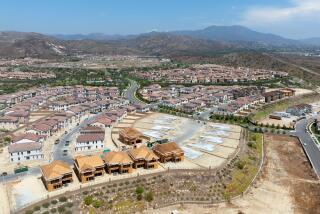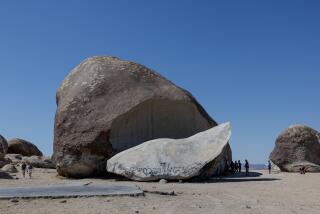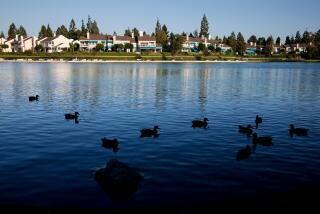TURTLE ROCK
There really is a rock in Irvine called Turtle Rock. But if you want to know where to find it, better ask a resident of the community near UC Irvine that was named for the 20-foot-high Miocene formation. Anyone else is likely to respond, “Is there a Turtle Rock?”
It’s there all right, albeit difficult to find now that it’s tucked away in a small hillside park in a maze of residential streets. It is unmarked by any plaque or sign, and the official Turtle Rock Community Park is on the other side of the hill.
Irvine Ranch farmers called it Frog Rock when it was surrounded by a barley field instead of housing. And even though some historians say the area was commonly used by the Juaneno Indians, it is the Gabrielino Indians who are credited with naming it Turtle Rock--long before the bulldozers came. The rock, which is about 60 feet wide and weighs an estimated 20 tons, resembles a turtle when viewed from a particular angle. No other explanation for the name has ever been cited.
Even though relatively obscure, Turtle Rock has meant many things to many people over the years and has been the subject of some controversy. In 1967, the Irvine Co. disclosed that the rock might be removed if it didn’t fit in with plans to develop the area. But the Pacific Coast Archeological Society protested the idea and planners found a way to work around it.
In the early 1980s the rock became popular with local rock climbers, which horrified local Gabrielino Indians, to whom the formation has been sacred for hundreds of years. To them, the piton-driving climbers scaling the rock were committing a destructive sacrilege. Local tribal leaders demanded that the city of Irvine fence the formation. Instead, the city planted bougainvillea around the rock, which, officials said, would deter climbers and vandals.
The Gabrielinos sanctified the rock on Aug. 19, 1984, and held religious ceremonies there for a short time afterward. But to climbers and neighborhood children, the rock still presents an irresistible challenge, and it is routinely scaled and pitons driven into its surface, which contains several embedded fossilized seashells.
“It’s hard for non-native people to understand Indian religious concepts,” says Paul Apodaca, a curator at the Bowers Museum.
“Native peoples are wed to the land, and natural features are the focal point for their symbolic explanations of life events such as birth, death and creation. Any unusual feature in the surrounding landscape like rocks, valleys, distinctive coastlines or large plants become highly significant in tribal religious imagery,” he said.
Turtle Rock may no longer be the controversial landmark it once was, but perhaps the quietude has assisted in its preservation. It sits on a hillside overlooking the San Diego Freeway, unmarked by graffiti, mute and unaware of all the memories and controversies it has generated through the years.
Location: Corner of Valley View and Rockview Drive, Irvine
More to Read
Sign up for Essential California
The most important California stories and recommendations in your inbox every morning.
You may occasionally receive promotional content from the Los Angeles Times.










